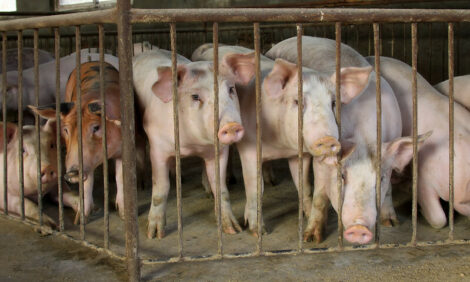



Researchers Discover Combined Viruses Are More Deadly
US - Mutated strains of porcine circovirus are posing dangerous threats to the world's pig populations, say Purdue University researchers. The virus is combining with other pathogens which makes it increasingly difficult to control or treat. |
Evidence from research being conducted at the Indiana Animal Disease Diagnostic Laboratory on the Purdue campus has indicated that the most recent mutation of porcine circoviruses can cause widespread acute disease. Other pathogens can combine with the virus to increase the fatality rate and as yet vets and producers do not have the resources to deal with these potential health hazards.
Researchers say that it is not known why a virus that has been infecting swine for almost 40 years in North America has suddenly started causing disease in young pigs in 1991. Since then it has mutated into more deadly forms.
"Our goal is to help the hog industry by understanding porcine circoviruses better," said Roman Pogranichniy, a Purdue School of Veterinary Medicine virologist and a scientist with the lab (pictured above).
In the ongoing study to determine how the mutated form of porcine circovirus - PCV2-1a - causes more deadly illness, the scientists have studied pigs exposed to a virus combination. The viruses, PCV2 and bovine viral diarrhea virus, came from pigs that had developed the diseases on the farm.
New Factors
"We think that the new co-factors, including bovine viral diarrhea virus-like pathogen and other swine viruses, work together with porcine circovirus to attack the animals' systems and become more virulent," Pogranichniy said.Studying virus-caused lesions and blood of PCV2-infected pigs provided some indications of how the virus enters the animals' cells, the scientists said. This helps them understand the process that allows circovirus-related diseases to progress and become more deadly.
"Results of the study also indicated that the amount of the PCV2 virus found in the animals had a direct relationship to how sick the pigs became," Pogranichniy said. "There was a high correlation between the amount of PCV2 viral DNA in the lesions and the severity of the disease."
During the past decade porcine circoviruses have spread to almost every area of the world where hogs are raised, but the mortality rate per herd is usually low. On farms infected with other viruses in addition to the new form of porcine circovirus disease, however, the mortality rate rose to 35 percent to 50 percent. Porcine circoviruses do not infect people.
Three commercial vaccines against PCV2 are available in the US market. It was reported that a recently developed vaccine against PCV2 will reduce mortality, but testing on the newest porcine circovirus form is ongoing.
Scientists first identified one type of porcine circovirus in 1974 in Europe. Further study showed that it had been present in pigs since at least 1969, but didn't cause apparent disease.
In 1991 a disease appeared in six to 11-week-old nursery pigs. They lost weight, developed lesions on their organs and often had respiratory problems, diarrhea and jaundice. The disease was called post-weaning multi-systemic wasting syndrome.
Porcine circovirus type 2 (PCV2), identified in 1996, causes lesions in the lymph tissues, kidney, liver and lungs. A more deadly form of post-weaning disease now also is found in older pigs. PCV2 also contributes to other swine health problems, including abortion, pneumonia and systemic infection. In addition to those consequences, the newest mutation causes enlargement of the spleen and fluid in the body cavity, lungs, abdomen and intestines.
More Investigations Needed
Further investigation needs to be conducted into cases of the latest porcine circovirus mutation that are characterized by the lesions produced in the blood vessels, Pogranichniy said. A more exact determination needs to be made of the role bovine viral diarrhea virus-like pathogen plays in development of circovirus diseases.The Purdue School of Veterinary Medicine, College of Agriculture and the National Pork Board have provided funding for the circovirus research. Collaborators on this research included Steve Lenz, Purdue veterinary pathologist and Animal Disease Diagnostic Laboratory researcher; Gregory Stevenson, formerly a Purdue and lab researcher and pathologist; Ingeborg Langohr and Huiling Wei, both Purdue veterinary comparative pathology graduate students; and Eric Nelson, a South Dakota State University virologist.






